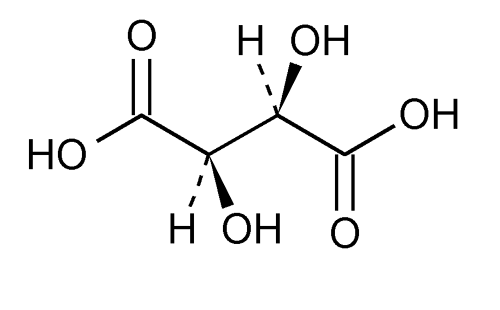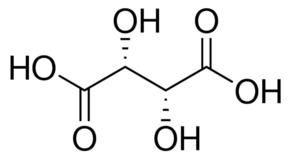Formula C4H6O6 Density 1.79 g/cm³ | Molar mass 150.087 g/mol Appearance white powder | |
 | ||
Related compounds | ||
Tartaric acid preparation
Tartaric acid is a white crystalline organic acid that occurs naturally in many plants, most notably in grapes. Its salt, potassium bitartrate, commonly known as cream of tartar, develops naturally in the process of winemaking. It is commonly mixed with sodium bicarbonate and is sold as baking powder used as a leavening agent in food preparation. The acid itself is added to foods as an antioxidant and to impart its distinctive sour taste.
Contents
- Tartaric acid preparation
- Tartaric acid meaning
- History
- Stereochemistry
- D tartaric acid
- Racemic tartaric acid
- Meso tartaric acid
- Reactivity
- Derivatives
- Tartaric acid in wine
- Applications
- References

Tartaric is an alpha-hydroxy-carboxylic acid, is diprotic and aldaric in acid characteristics, and is a dihydroxyl derivative of succinic acid.
Tartaric acid meaning
History

Tartaric acid was first isolated from potassium bitartrate circa 800 AD, by the alchemist Jābir ibn Hayyān. The modern process was developed in 1769 by the Swedish chemist Carl Wilhelm Scheele.

Tartaric acid played an important role in the discovery of chemical chirality. This property of tartaric acid was first observed in 1832 by Jean Baptiste Biot, who observed its ability to rotate polarized light. Louis Pasteur continued this research in 1847 by investigating the shapes of potassium sodium tartrate crystals, which he found to be chiral. By manually sorting the differently shaped crystals, Pasteur was the first to produce a pure sample of levotartaric acid.
Stereochemistry

Naturally occurring tartaric acid is chiral, and is a useful raw material in organic chemistry for the synthesis. The naturally occurring form of the acid is dextrotartaric acid or D-(-)-tartaric acid. Because it is available naturally, it is slightly cheaper than its enantiomer and the meso isomer. The dextro and levo prefixes are archaic terms. Modern textbooks refer to the natural form as 2S,3S-tartaric acid, and its enantiomer as 2R,3R-tartaric acid. The meso diastereomer is 2S,3R-tartaric acid, which is equivalent to 2R,3S-tartaric acid.

Whereas the two chiral stereoisomers rotate plane polarized light in opposite directions, solutions of meso-tartaric acid do not rotate plane-polarized light. The absence of optical activity is due to a mirror plane in the molecule [segmented line in picture below].
Tartaric acid in Fehling's solution binds to copper(II) ions, preventing the formation of insoluble hydroxide salts.
D-(-)-tartaric acid
The D-(-)-tartaric acid isomer of tartaric acid is industrially produced in the largest amounts. It is obtained from lees, a solid byproduct of fermentations. The former byproducts mostly consist of potassium bitartrate (KHC4H4O6). This potassium salt is converted to calcium tartrate (CaC4H4O6) upon treatment with milk of lime (Ca(OH)2):
KO2CCH(OH)CH(OH)CO2H + Ca(OH)2 → Ca(O2CCH(OH)CH(OH)CO2) + KOH + H2OIn practice, higher yields of calcium tartrate are obtained with the addition of calcium chloride. Calcium tartrate is then converted to tartaric acid by treating the salt with aqueous sulfuric acid:
Ca(O2CCH(OH)CH(OH)CO2) + H2SO4 → HO2CCH(OH)CH(OH)CO2H + CaSO4Racemic tartaric acid
Racemic tartaric acid (i.e.: a 50:50 mixture of D-(-)-tartaric acid and L-(+)-tartaric acid molecules) can be prepared in a multistep reaction from maleic acid. In the first step, the maleic acid is epoxidized by hydrogen peroxide using potassium tungstate as a catalyst.
HO2CC2H2CO2H + H2O2 → OC2H2(CO2H) 2In the next step, the epoxide is hydrolyzed.
OC2H2(CO2H)2 + H2O → (HOCH)2(CO2H)2Meso-tartaric acid
Meso-tartaric acid is formed via thermal isomerization. Dextro-tartaric acid is heated in water at 165 °C for about 2 days. Meso-tartaric acid can also be prepared from dibromosuccinic acid using silver hydroxide:
HO2CCHBrCHBrCO2H + 2 AgOH → HO2CCH(OH)CH(OH)CO2H + 2 AgBrMeso-tartaric acid can be separated from residual racemic acid by crystallization, the racemate being less soluble.
Reactivity
L-(+)-tartaric acid, can participate in several reactions. As shown the reaction scheme below, dihydroxymaleic acid is produced upon treatment of L-(+)-tartaric acid with hydrogen peroxide in the presence of a ferrous salt.
HO2CCH(OH)CH(OH)CO2H + H2O2 → HO2CC(OH)C(OH)CO2H + 2 H2ODihydroxymaleic acid can then be oxidized to tartronic acid with nitric acid.
Derivatives
Important derivatives of tartaric acid include its salts, cream of tartar (potassium bitartrate), Rochelle salt (potassium sodium tartrate, a mild laxative), and tartar emetic (antimony potassium tartrate). Diisopropyl tartrate is used as a catalyst in asymmetric synthesis.
Tartaric acid is a muscle toxin, which works by inhibiting the production of malic acid, and in high doses causes paralysis and death. The median lethal dose (LD50) is about 7.5 grams/kg for a human, 5.3 grams/kg for rabbits, and 4.4 grams/kg for mice. Given this figure, it would take over 500 g (18 oz) to kill a person weighing 70 kg (150 lb), so it may be safely included in many foods, especially sour-tasting sweets. As a food additive, tartaric acid is used as an antioxidant with E number E334; tartrates are other additives serving as antioxidants or emulsifiers.
When cream of tartar is added to water, a suspension results which serves to clean copper coins very well, as the tartrate solution can dissolve the layer of copper(II) oxide present on the surface of the coin. The resulting copper(II)-tartrate complex is easily soluble in water.
Tartaric acid in wine
Tartaric acid may be most immediately recognizable to wine drinkers as the source of "wine diamonds", the small potassium bitartrate crystals that sometimes form spontaneously on the cork or bottom of the bottle. These "tartrates" are harmless, despite sometimes being mistaken for broken glass, and are prevented in many wines through cold stabilization (which is not always preferred since it can change the wine's profile). The tartrates remaining on the inside of aging barrels were at one time a major industrial source of potassium bitartrate.
Tartaric acid plays an important role chemically, lowering the pH of fermenting "must" to a level where many undesirable spoilage bacteria cannot live, and acting as a preservative after fermentation. In the mouth, tartaric acid provides some of the tartness in the wine, although citric and malic acids also play a role.
Applications
Tartaric acid and its derivatives have a plethora of uses in the field of pharmaceuticals. For example, it has been used in the production of effervescent salts, in combination with citric acid, to improve the taste of oral medications. The potassium antimonyl derivative of the acid known as tartar emetic is included, in small doses, in cough syrup as an expectorant.
Tartaric acid also has several applications for industrial use. The acid has been observed to chelate metal ions such as calcium and magnesium. Therefore, the acid has served in the farming and metal industries as a chelating agent for complexing micronutrients in soil fertilizer and for cleaning metal surfaces consisting of aluminium, copper, iron, and alloys of these metals, respectively.
